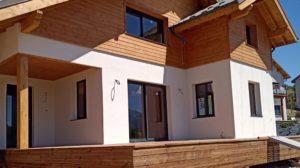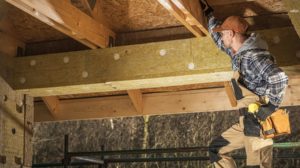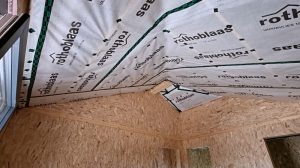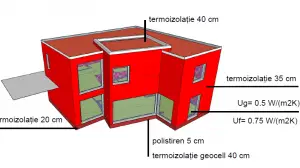NZEB is a building efficiency standard. From 2021, all new buildings - houses, blocks of flats, schools, kindergartens, hospitals, sports halls or auditoriums - must comply with this standard. NZEB is short for near zero energy building which means near-zero energy building. The concept emerged at European Community level to reduce energy consumption in residential buildings. EU Directive 31/2010 obliges all Member States to implement measures to reduce energy consumption, starting from December 31, 2018 for new state-run buildings and from December 31, 2020 for new privately-owned buildings.
Law 101/2020 on the energy performance of buildings is what makes the standard mandatory in Romania. As a result, the design and construction of new buildings must be done in such a way that the energy consumption for their maintenance (heating, hot water, ventilation, lighting) is very low, while comfort remains high. The publication in the Official Journal of Methodology for calculating the energy performance of buildings, in January 2023, comes with clear calculation methods for architects, designers and builders. Now all the elements are in place to correctly build energy efficient homes to NZEB standard.
What is NZEB
According to Law 101/2020, the definition of an NZEB-built building is "a building with very high energy performance, where the energy demand for energy performance is close to zero or very low and is covered as follows: (a) in a proportion of at least 30%, with energy from renewable sources, including energy from renewable sources produced on-site or nearby, within a radius of 30 km from the GPS coordinates of the building, from 2021 onwards; (b) the minimum proportions of energy from renewable sources, including energy from renewable sources produced on-site or nearby, within a radius of 30 km from the GPS coordinates of the building, for the periods 2031-2040, 2041-2050 and after 2051, shall be determined by Government Decision"
The European Union has recommended increasing the share of renewables to 80% after 2050, with each country setting the level for each period. This is what point b) refers to. The recent energy crisis has led to an acceleration of this plan at European level, with the new target of 801TPT3T of renewable energy to be reached by 2040.
The near-zero energy buildings standard was known as nZEB. Capitalization at the beginning, i.e. NZEB (net zero energy building), used to define buildings that use no conventional energy or, if they do, recover all of it. With the publication of the Calculation Methodology, the NZEB has been formalized in Romania as the Near Zero Energy Buildings standard.
Which buildings must meet the NZEB standard
All residential, office, educational, sports, sports, hospital and entertainment buildings, i.e. all newly constructed buildings for people, where heating, hot water and lighting are needed. Buildings undergoing major renovation must also meet the NZEB standard. Major refurbishment is defined as an intervention with a value greater than 25% of the value of the building. Exempted from the NZEB standard are historical monuments, places of worship and projects approved before the law was published.
Everyone designing or constructing new buildings should be aware of the regulations of the standard. Without proper energy compliance, the project will not be able to receive planning permission, and a building that does not meet the NZEB criteria will not be accepted.
Clarifications brought by the methodology
Although the law was published in 2020, the lack of methodology for calculating and applying the various parameters (insulation thickness, heat transfer coefficient, air exchanges, etc.) has created a lot of confusion, left room for interpretation and so ways have been found to get around it. The emergence of Methodology for calculating the energy performance of buildings clarifies things for architects, designers and builders as well as beneficiaries. It is a comprehensive document dealing with all aspects of the building: envelope, type and fitting of windows, installations used, documents required, comfort.
The main requirements for NZEB residential buildings specified in the methodologies are:
- an annual maintenance energy consumption at a certain level. For example, for residential buildings, it should be between 120.1 kWh/m² and 147.9 kWh/m² per year. The difference is due to construction in different climatic zones, the heating requirement depending on how cold the zone is);
- maximum greenhouse gas emission value. For residential buildings, it should be between 14.7 kg/m² and 19.9 kg/m² per year, also differentiated by climate zones;
- producing 301TPTP3T of the required energy from renewable sources.
A summary of the methodology made by Marius Șoflete, with explanations and clarifications, can be found here here.
How to build to achieve the NZEB standard
The largest energy consumer in Romania is the buildings sector, both private and public. The consumption of thermal energy for heating the building and obtaining domestic hot water represents about 701TPTP3T of the total energy consumption. By 2020, the annual energy consumption of residential buildings was in the range of 180-400 kWh/m². Now is the time to build better and more responsibly to change this.
The energy consumption of a building depends on the insulation systems, the level of performance of the windows, how economical the lighting system is, how efficient the heating, ventilation or air conditioning systems are. The choice of these systems and their correct installation determines the energy performance of the building. The energy configuration is made at the design stage, according to the annual energy consumption to be achieved, i.e. that required by the NZEB standard.
Providing a continuous and sufficiently thick thermal envelope, high performance windows with low heat transfer coefficient, both in glass and frame, elimination of thermal bridges, elimination of uncontrolled air exchange with the outside, heat recovery ventilation system, economical lighting, comfort level are important key factors in achieving the NZEB standard.
What are the advantages of NZEB construction for the beneficiary
The first big advantage is the significant decrease in energy consumption. We saw this year what an energy crisis means. Reducing the energy needed to run the building means very low maintenance bills.
Replacing some of the energy consumed with renewable energy is another advantage. Reducing fossil fuel consumption means less pollution and cleaner air.
Always fresh air and good lighting have a positive influence on the quality of life of residents. Studies have shown that mental well-being is also much better in such an environment.
Why it is good that Romania is implementing this EU directive
Directive 31/2010 of the European Union obliged us to implement the NZEB standard and to make building efficiency programs. It was our good fortune. Now we have no choice but to build more economical, comfortable and healthy houses. The energy crisis caused by the border conflict has shown us how risky energy dependency is. The lower the consumption and the more varied the energy sources, the less we are affected by global price fluctuations and raw material crises caused by armed conflicts or other events.
Caravan nZEB Roadshow in Iasi and especially nZEB Week in Cluj showed us how effervescent the construction industry has become. The NZEB standard has taken it to a new level, and we all stand to gain.




































Hello,
Directive 31 is from 2010 not 2020
Correction. Thank you.